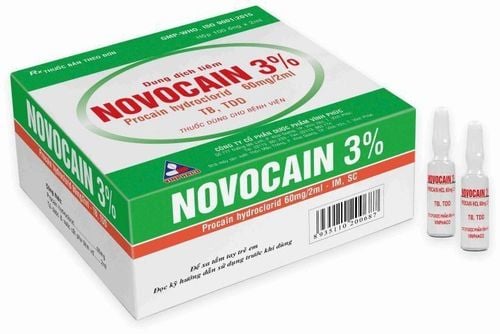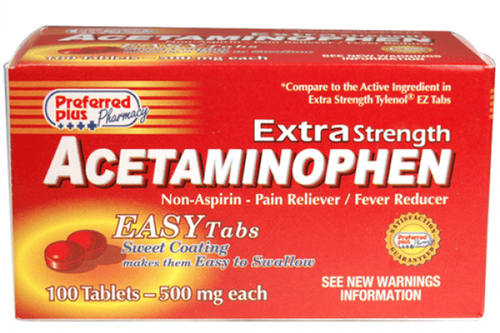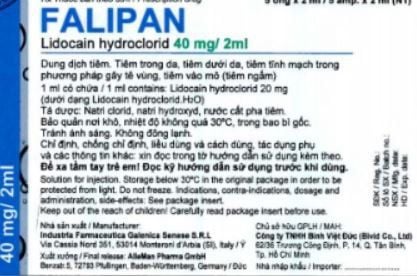This is an automatically translated article.
Anaropin is an anesthetic drug, the main ingredient is Ropivacain HCl. Anaropin is used for surgical anesthesia, infusion to relieve acute pain in both adults and children.1. Anaropin drug use
Anaropin belongs to the group of anesthetics and anesthetics, with the main ingredient being Ropivacaine HCl 5mg/ml (in the form of Ropivacaine HCl monohydrate).
Anesthesia Anaropin is prepared in the form of an injectable solution and is indicated for use in the following cases:
Anesthesia in surgery: Epidural anesthesia for surgery, caesarean section; intramedullary anesthesia (subarachnoid); major nerve block, peripheral nerve block; selective regional anesthesia. Acute analgesia: Intermittent or continuous epidural high-dose Anaropine infusion for postpartum analgesia or selective regional anesthesia surgery. Intermittent injection or infusion of a continuous peripheral nerve block for the management of acute pain after surgery. Acute analgesia in children during and after surgery: sacral lumbar epidural block, continuous epidural infusion in neonate
2. How to use and dose Anaropin
2.1 How to take Anaropin Anaropin is given by infusion and this should be done by a healthcare professional or a doctor.
How to use Anaropin in adults and children over 12 years old as follows: Slow injection at a rate of 25 - 50mg/min, can be injected whole or divided into doses and injected continuously. Care should be taken before and during injection, especially when high doses of epidurals need to be tested first. When injecting Anaropine drug should be avoided inadvertently injecting into the blood vessels or intramedullary, because the drug can increase heart rate (occurs only for a short time) and cause signs of spinal block. If the patient shows signs of toxicity, the injection should be stopped immediately. How to use Anaropin in children under 12 years old: Before and during injection, it is necessary to carefully suck the syringe to avoid injecting into a blood vessel by mistake. During the injection process, the patient's vital functions should be closely monitored. If there are symptoms of drug toxicity, the injection should be stopped immediately. Dosage should be divided based on the calculated dose. 2.2 Dosage of Anaropin Drug dosage Anaropin in adults and children over 12 years old in specific acute pain relief is as follows:
Lumbar epidural injection: High dose injection volume from 10 to 20ml, dose from 20ml - 40mg. The onset time is from 10 to 15 minutes, the numbing time is from 0.5 to 1.5 hours. Injection of Anaropin (during delivery) with a volume of 10 - 15ml (minimum interval between 2 injections is 30 minutes), the dose is from 20 - 30mg. Continuous infusion (in pain relief after surgery) volume from 6-14ml, dose from 12 to 28mg. Chest epidural injection: Continuous infusion of Anaropine (in pain relief after surgery) with a volume of 6-14ml/hour, the dose is from 12-2mg/hour. Selective anesthesia and peripheral nerve blockade volume from 1-100ml, dose is from 2-200mg, onset time from 1 to 5 minutes and duration of anesthesia from 2-6 hours. Peripheral nerve block in the thigh or trapezius muscle: Anaropine infusion is intermittent or continuous with a volume of 5 - 10 ml/hour, the dose is 10 - 20 mg/hour. Dosage of Anaropin in children under 12 years of age in the treatment of acute pain is as follows:
Epidural block in the sacral region: Single dose treatment, continuous epidural infusion with a volume of 1 ml/kg Dosage is 2mg/kg. Children under 25 kg: Children from 0 to 6 months old high dose infusion up to 72 hours with a volume of 1ml/kg, the dose is 2mg/kg. Children from 6-12 months old infusion of high-dose Anaropine with a volume of 0.5 - 1ml/kg, the dose is from 1 - 2mg/kg; Infusion up to 72 hours at a volume of 0.1ml/kg/hour, the dose is 0.2mg/kg/hour. Children from 1 to 12 years old infusion with a high dose of 1ml/kg, the dose is 2mg/kg; Infusion up to 72 hours at a volume of 0.2ml/kg/hour, the dose is 0.4mg/kg/hour. 2.3 What to do in case of an overdose of Anaropine Infusion of Anaropine overdose can cause acute systemic toxicity, at which time, it is necessary to stop using the drug immediately and initiate direct measures to quickly stop the symptoms. symptoms in the central nervous system. If necessary, give the patient continuous oxygen to ventilate.
In case the convulsions caused by an overdose of Anaropin drug do not stop automatically after about 15-20 seconds, the patient should receive respiratory support with intravenous measures of Sodium Thiopentone 1-3mg/kg or Diazepam 0.1mg/ kg.
To improve ventilation and oxygenation due to Anaropin overdose, the patient needs to be injected with muscle relaxants. Perform cardiopulmonary resuscitation when the patient shows signs of circulatory arrest.
In case of overdose of Anaropin causing hypotension or bradycardia, Ephedrine should be administered intravenously 5 - 10 mg and can be repeated after 2 to 3 minutes. Cardiac massage if the patient has heart failure and prolonged resuscitation if cardiac arrest improves outcomes.
Note in the management of Anaropin poisoning in children that the dose of the drug needs to be calculated specifically based on the weight and age of the child.
3. Side effects and notes when taking Anaropin
Anaropine anesthetic can cause some unwanted side effects with the frequency of occurrence as follows:
Very common: Hypotension, nausea. Common: Slow or fast heart rate, increased blood pressure; headache, dizziness, paresthesia; vomit; urinary retention; back pain, chills, increased temperature, chills, back pain. Uncommon: Anaropine rarely causes syncope; restlessness, manifestations of central nervous system toxicity such as numbness of the tongue, dysarthria, tinnitus, increased hearing, darkening of the eyebrows, visual disturbances, tremors, myoclonic jerks, convulsions, seizures, seizures; decreased touch; shortness of breath; lower the temperature. Rare: Arrhythmia, cardiac arrest; urticaria, allergic reactions, neuroma. Common side effects after spinal anesthesia with Anaropin include: hypotension, headache, dizziness, paresthesia, vomiting, dyspnea, bradycardia, urinary retention, hypothermia, syncope. In particular, children rarely have low blood pressure but are very prone to vomiting.
Common side effects caused by injection into the wrong blood vessel, an overdose of Anaropine or rapidly absorbed drugs include: Restlessness, CNS toxicity.
Note, do not use Anaropin anesthetic in people with hypersensitivity to the drug's ingredients or local anesthetics of the Amide group. If there are any strange or unusual symptoms, the patient and relatives should immediately contact a medical staff or doctor.
The use of Anaropin is to numb or induce anesthesia in surgery, including caesarean section. In addition, Anaropin also works to reduce acute pain during and after surgery by infusion.
Please dial HOTLINE for more information or register for an appointment HERE. Download MyVinmec app to make appointments faster and to manage your bookings easily.













